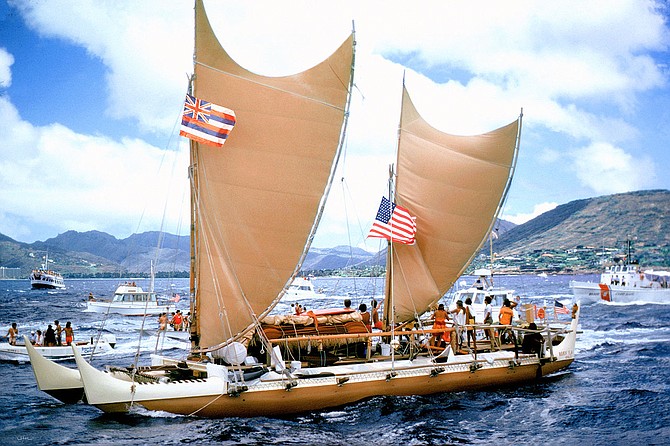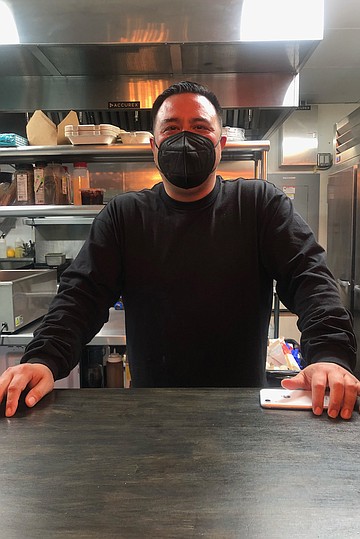 Facebook
Facebook
 X
X
 Instagram
Instagram
 TikTok
TikTok
 Youtube
Youtube

“Me?” says Robert Alfonso. “I am a half-breed.” He says it just as a matter of fact. No apology, no irony. A statement about his life as an “Indo-Dutch” child. We’re sitting at his new Cafe Indonesia in National City, one of the first such in San Diego. He says people remember the British Empire, but not the Dutch Empire, except for Apartheid South Africa. But they ruled Indonesia, and all of its 17,500 islands, for centuries.
Alfonso comes from generations of strictly segregated inhabitants of what was the Dutch East Indies. “The indigenous folks kept in their own world, the half-breeds like me and my family were kept in our own world, and the Dutch themselves kept in their own world. That’s how it was. I am the product of Dutch and Indonesian grandparents. It doesn’t matter here, now, but things weren’t so cool back in the day.” So how does he — this kid of Dutch culture, Filipino ancestry, and American surroundings — think of himself? “I consider myself an Austronesian, from the Pacific, even though I always get tagged with ‘Mexican.’ In Indonesia, where I did a lot of growing up as Indo-Dutch, they call us half-breeds. We’re half Dutch, half Indonesian. In Indonesia, we’re clearly not full indigenous, and we’re clearly not full white. We half-breeds were higher ranking than the indigenous people, but not as high as the Dutch. That’s how it was for 400 years.”

“Austronesian,” turns out, is a huge grouping. “We stretch all the way from New Zealand to the eastern coast of Madagascar. The Malagasy live right beside Africa, but they are also Austronesian. To look at, you can’t tell whether they’re Filipino or from Indonesia, but you definitely know they’re not from the African sub-continent. And all our languages are related.” In fact, he has a theory: recent evidence, he says, shows that once upon a time, people of the Pacific, from San Diego to Saipan, used common words and shared common roots of hundreds, maybe thousands of languages, and that this root language emerged from one place: Taiwan. Remarkably, he first became conscious of this cultural commonality as a kid. “When I was growing up, I went to school all across the Pacific, because my father worked for the U.S. Navy,” he says. “I was always changing schools. And in each, we had cultural sensitivity classes. In Japan, when I was in the 6th grade, we learned about Japanese culture. In the 7th Grade when I was in the Philippines, we learned Filipino cultures and customs. Then it was Guam. All had their cultural classes. And I began to spot similarities.”
Unlike many of the other kids, he didn’t speak Spanish. “My grandpa came from Mississippi in the 1930s to be in the logging business. He died in the Bataan Death March in World War II. After World War II, we [mixed blood people] were getting more and more marginalized. In the fight for independence, anybody with a drop of Dutch blood, European blood, was singled out, killed, or whatever the case was. So they asked [the Dutch in Holland] to take us in. And since, the U.S. has opened its doors. And a lot of us settled right here in San Diego. When we moved to the U.S. mainland when I was 17, I thought of myself as Filipino, even though English and Dutch were my languages. But there were things we all shared, like customs: how we spoke to elders, for instance. Everybody had an honorific: ‘Uncle’ or ‘Auntie.’ You’d never just address an older person by their name, without an honorific. Or, when you’re feeding guests, you always feed them till they explode. ‘No’ never means ‘no.’ Or punctuality: being on time is always flexible. Yes, to an American, being on time is sacred. But to our culture, to worry about time like that would seem harsh and impolite. Some customs were very different, but these attitudes were common to most Pacific Islanders and Asians.”
Those were the sorts of things he started to notice, growing up all over the Pacific. And while he spoke Dutch and English, he was used to a plethora of languages. “I gradually started to hear similar words being spoken in different Pacific languages, from Hawaii to Indonesia to Native American languages. Common words, like numbers. Words for life, death, love, children. I discovered that these words have been more or less the same since forever. There is a pan-Pacific language. It’s just slightly underground.” But it persists, and that suggests that the ancients communicated. “Look at Pacific navigation. The largest stretches of ocean in the world. The wisdom and learning of navigation had disappeared among all except the Yap islanders, southwest of Guam. But they still remembered how to navigate — in recent times, without any modern instruments. And the instructions, which they remembered by turning them into songs and poems, are the key to how the ancients all navigated.”
And, he suspects, the main key is Taiwan, a seedbed of pan-Pacific culture. Recent research affirms that emigrants from China set sail from Taiwan to settle the islands, and that Taiwan became a source culture for the languages that spread as far as South America. “Back then, in ancient times, people could communicate with each other,” says Robert. “Just look at numbers: everyone across the Pacific still uses the same numbers as in ancient times.” He learned all this the hard way. Growing up in San Diego, he says, was cool — mostly. “It has diversity, but not everywhere. For instance as an Indo-Dutch immigrant, I just still feel uncomfortable in places like Santee, La Mesa, inland. I feel better in National City and Chula Vista. Even though I’m not Mexican, people say I look Mexican.”


“Me?” says Robert Alfonso. “I am a half-breed.” He says it just as a matter of fact. No apology, no irony. A statement about his life as an “Indo-Dutch” child. We’re sitting at his new Cafe Indonesia in National City, one of the first such in San Diego. He says people remember the British Empire, but not the Dutch Empire, except for Apartheid South Africa. But they ruled Indonesia, and all of its 17,500 islands, for centuries.
Alfonso comes from generations of strictly segregated inhabitants of what was the Dutch East Indies. “The indigenous folks kept in their own world, the half-breeds like me and my family were kept in our own world, and the Dutch themselves kept in their own world. That’s how it was. I am the product of Dutch and Indonesian grandparents. It doesn’t matter here, now, but things weren’t so cool back in the day.” So how does he — this kid of Dutch culture, Filipino ancestry, and American surroundings — think of himself? “I consider myself an Austronesian, from the Pacific, even though I always get tagged with ‘Mexican.’ In Indonesia, where I did a lot of growing up as Indo-Dutch, they call us half-breeds. We’re half Dutch, half Indonesian. In Indonesia, we’re clearly not full indigenous, and we’re clearly not full white. We half-breeds were higher ranking than the indigenous people, but not as high as the Dutch. That’s how it was for 400 years.”

“Austronesian,” turns out, is a huge grouping. “We stretch all the way from New Zealand to the eastern coast of Madagascar. The Malagasy live right beside Africa, but they are also Austronesian. To look at, you can’t tell whether they’re Filipino or from Indonesia, but you definitely know they’re not from the African sub-continent. And all our languages are related.” In fact, he has a theory: recent evidence, he says, shows that once upon a time, people of the Pacific, from San Diego to Saipan, used common words and shared common roots of hundreds, maybe thousands of languages, and that this root language emerged from one place: Taiwan. Remarkably, he first became conscious of this cultural commonality as a kid. “When I was growing up, I went to school all across the Pacific, because my father worked for the U.S. Navy,” he says. “I was always changing schools. And in each, we had cultural sensitivity classes. In Japan, when I was in the 6th grade, we learned about Japanese culture. In the 7th Grade when I was in the Philippines, we learned Filipino cultures and customs. Then it was Guam. All had their cultural classes. And I began to spot similarities.”
Unlike many of the other kids, he didn’t speak Spanish. “My grandpa came from Mississippi in the 1930s to be in the logging business. He died in the Bataan Death March in World War II. After World War II, we [mixed blood people] were getting more and more marginalized. In the fight for independence, anybody with a drop of Dutch blood, European blood, was singled out, killed, or whatever the case was. So they asked [the Dutch in Holland] to take us in. And since, the U.S. has opened its doors. And a lot of us settled right here in San Diego. When we moved to the U.S. mainland when I was 17, I thought of myself as Filipino, even though English and Dutch were my languages. But there were things we all shared, like customs: how we spoke to elders, for instance. Everybody had an honorific: ‘Uncle’ or ‘Auntie.’ You’d never just address an older person by their name, without an honorific. Or, when you’re feeding guests, you always feed them till they explode. ‘No’ never means ‘no.’ Or punctuality: being on time is always flexible. Yes, to an American, being on time is sacred. But to our culture, to worry about time like that would seem harsh and impolite. Some customs were very different, but these attitudes were common to most Pacific Islanders and Asians.”
Those were the sorts of things he started to notice, growing up all over the Pacific. And while he spoke Dutch and English, he was used to a plethora of languages. “I gradually started to hear similar words being spoken in different Pacific languages, from Hawaii to Indonesia to Native American languages. Common words, like numbers. Words for life, death, love, children. I discovered that these words have been more or less the same since forever. There is a pan-Pacific language. It’s just slightly underground.” But it persists, and that suggests that the ancients communicated. “Look at Pacific navigation. The largest stretches of ocean in the world. The wisdom and learning of navigation had disappeared among all except the Yap islanders, southwest of Guam. But they still remembered how to navigate — in recent times, without any modern instruments. And the instructions, which they remembered by turning them into songs and poems, are the key to how the ancients all navigated.”
And, he suspects, the main key is Taiwan, a seedbed of pan-Pacific culture. Recent research affirms that emigrants from China set sail from Taiwan to settle the islands, and that Taiwan became a source culture for the languages that spread as far as South America. “Back then, in ancient times, people could communicate with each other,” says Robert. “Just look at numbers: everyone across the Pacific still uses the same numbers as in ancient times.” He learned all this the hard way. Growing up in San Diego, he says, was cool — mostly. “It has diversity, but not everywhere. For instance as an Indo-Dutch immigrant, I just still feel uncomfortable in places like Santee, La Mesa, inland. I feel better in National City and Chula Vista. Even though I’m not Mexican, people say I look Mexican.”
Comments